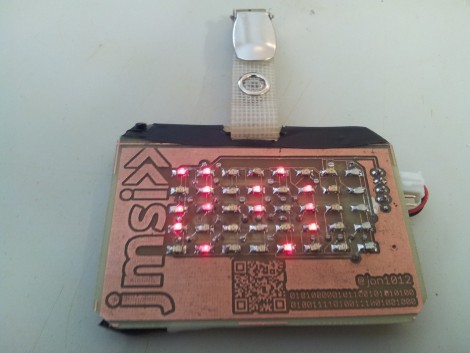
It used to be that the contents of your pocket protector directly mirrored your geek level. But that just doesn’t cut it in our fast-paced digital age. We think [Jonathan] is headed down the right track though, by creating a scrolling LED name badge which he takes to conventions with him. With the right enclosure this could reach the same geek level as Woz’s watch. There’s a lot packed into the little device, but readability at close range doesn’t look like one the features so make sure you glance at the tag before you approach him for a conversation.
As you can see, the PCB for the project is the same form factor as a landscape ID card. It hosts an 8×5 LED matrix, which meshes nicely with the registers of the MSP430 chip which runs it. He admits that the hardware may not last very long as the chip is multiplexing the display directly, with no resistors or LED drivers for current protection. But there is potential in the design. It uses a rechargeable battery (which we like) and he included a QR code in the board artwork for easy exchange of contact information. We’ve embedded his description of the project after the break.[youtube=http://www.youtube.com/watch?v=k1NqT2BIg6E&w=470]





Someday my PCBs will turn out that well.
Since he’s using a li-poly battery, it’s unlikely that the LEDs will be damaged any time soon without current limiting, especially since it’s a strobed matrix. Probably last for longer than the PCB.
Not to knock the addition of the QRCode, I love it, but perhaps spacing it somewhere a bit further from the LEDs would help.
That column on the right don’t work
“…doesn’t work”
That QR code is inverted, I doesn’t think this will be readable.
LMAO Screw you Grammar Nazis!
as for the led thing, assuming lion or lipo battery:
use green LEDs, DONE
the red is ~1.8v @max current, the BJT in uC is ~0.75 @max current but times two (multiplexed), so total circuit drop is ~3.3, the battery would drop from its fullfull voltage of ~4.19 for lion i think very quickly and after that the LEDs would “wear-out” at normal speed until charged again.
at the current he’s pushing, i’d imagine he’d ruin the LEDs in several hours of constant light,,, but the battery would quickly drop to safe levels in like 15 mins if the battery is a tiny bluetooth headset battery, which is prettymuch the max weight u can have before a T-shirt starts to sag!
not to mention the cooling effect of multiplexing, they look more dim and use less total power per minute, and its the heat that destroys them. 🙂
@t&p: Yeah the last column didn’t work because of a badly soldered via, it’s now corrected.
@Jack: The qr code is readable by some software but indeed not all (it worked with 70% of people who tried at FOSDEM).
About the badge, it’s on for full time since last friday without a recharge. Also, the uC goes into low power between each row.
It’s a 2000mAh li-poly battery, which is light (in term of weight).
What saves the life of the leds is that it’s multiplexed and that the uC doesn’t handle too much current (max 15mA per channel, I choose this msp430 over the value lines one for this reason, more current handling) and does a current drop (I think the uC is at risk when the remperature goes too high).
BTW: FOSDEM was awesome (again) – everybody who missed it missed a lot of cool, interesting & inspiring projects and speeches.
Just sayin’ 🙂
ag.
It seems like using a resistor and a LED’s would help make this last longer and be more functional.